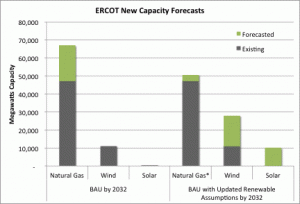 An interesting fact seemed to go unnoticed in all the press around the Electric Reliability Council of Texas’s (ERCOT) Long Term System Assessment, a biennial report submitted to the Texas Legislature on “the need for increased transmission and generation capacity throughout the state of Texas.” ERCOT found that if you use updated wind and solar power characteristics like cost and actual output to reflect real world conditions, rather than the previously used 2006 assumed characteristics, wind and solar are more competitive than natural gas over the next 20 years. This might seem a bit strange since we’ve been told for years by renewable energy skeptics that wind and solar power can’t compete with low natural gas prices. Let me back up a second and explain what’s going on here, and what it means for both the energy crunch and Texas’ ongoing drought.
An interesting fact seemed to go unnoticed in all the press around the Electric Reliability Council of Texas’s (ERCOT) Long Term System Assessment, a biennial report submitted to the Texas Legislature on “the need for increased transmission and generation capacity throughout the state of Texas.” ERCOT found that if you use updated wind and solar power characteristics like cost and actual output to reflect real world conditions, rather than the previously used 2006 assumed characteristics, wind and solar are more competitive than natural gas over the next 20 years. This might seem a bit strange since we’ve been told for years by renewable energy skeptics that wind and solar power can’t compete with low natural gas prices. Let me back up a second and explain what’s going on here, and what it means for both the energy crunch and Texas’ ongoing drought.
Every two years since 2005, ERCOT has used a series of complex energy system models to model and estimate future conditions on the Texas electric grid. This serves a critical function for legislators, utilities and regulators and others who need to prepare for changes as our electric use continues to expand and evolve. As with any model of this kind, the assumptions are critical: everything from the price of natural gas, to the cost to build power plants and transmission lines. Facing an acute energy crunch and given that solar and wind costs have come down a great deal since the first study in 2006, ERCOT dug a little deeper into their historical assumptions and developed a version of the model that used current, real-world cost and performance data for wind and solar power.
What they found was astounding: without these real-world data points, ERCOT found that 20,000 MW of natural gas will be built over the next 20 years, along with a little bit of demand response and nothing else. Once they updated their assumptions to reflect a real-world scenario (which they call “BAU with Updated Wind Shapes”) ERCOT found that about 17,000 MWs of wind units, along with 10,000 MW of solar power, will be built in future years.
In addition to demonstrating the economic viability of renewable energy, these results show two drastically different futures: one in which we rely overwhelmingly on natural gas for our electricity, and one in which we have a diverse portfolio of comparable amounts of renewable energy (which does not use water) and natural gas. All of this is crucial to keep in mind as the Legislature, the Public Utility Commission and ERCOT evaluate proposals to address resource adequacy concerns and the impacts of a continuing drought on our state’s energy supply.
Finally, one ERCOT statement in particular stands out from this analysis, in direct contradiction to renewable energy opponents who say that renewable energy is too expensive: “the added renewable generation in this sensitivity results in lower market prices in many hours [of the year].” This means that when real-world assumptions are used for our various sources of power, wind and solar are highly competitive with natural gas. In turn, that competition from renewables results in lower power prices and lower water use for Texas.
As state leaders look for ways to encourage new capacity in the midst of a drought, it’s important to realize that renewable energy is now competitive over the long term with conventional resources. The fact that renewable energy resources can reduce our water dependency while hedging against higher long-term prices means that however state leaders decide to address the energy crunch, renewables need to be part of the plan.










5 Comments
Appreciate your comment and highlighting the report – let’s see what our legislature, in all their collective wisdom, which ain’t much – does with this information. That’s assuming Perry hasn’t forbid his appointed PUC from reading the report, having himself deemed it heresy
Of course wind and solar energy have lower fuel costs than natural gas. This is why wind and solar are dispatched ahead of natural gas. However when wind and solar are not present, then we rely on natural gas as the backup resource, so we can reduce the energy generated by natural gas but we cannot cut our ties with the generation capacity that natural gas provided. So natural gas is a necessary evil as wind and solar are expanded.
I used the ERCOT hourly wind and load data for 2012 to create a scenario where I pushed wind to a maximum level, I assumed that wind could be increased until there was a lot of spilled wind energy. My objective was to see how much of ERCOTs energy could be served using wind alone. The answer is no more than 50% wind energy if ERCOT had 58 GW last year and this would result in at least a 4% energy spillage of wind. I had no solar in the plan. Interestingly the amount of natural gas capacity needed remained at about the peak load level of 66 GW even when there is 58 GW of wind because there are times when the wind in both west Texas and along the coast is not blowing during the summer time peak load periods.
So no matter how much we want to eliminate or compete with fossil fuels, they remain with us until we have a more relaible source of power than wind and solar can provide.
Hi Gene,
Your scenario seems a very limited one from which to drawn such a broad conclusion. If you have no solar (or other none wind renewable) and presume a dead wind day across the entire state (it can happen), then of course you need on demand generation capacity equal to peak load. You are also presuming no storage capability growth, no growth in ISO interconnection, and etc. I presume that some transmission or nodal congestion limitation comes into play to limit the total wind penetration feasible.
Germany (a market with total peak demand comparable to ERCOT) has already experienced days of 50% production penetration by solar energy. Given that TX is a summer peaking demand market (vs. winter for Germany) and TX has much better solar insolation there is every reason to believe that we could meet all future peak demand growth with renewable resources in the coming decades.
You have also used the word “reliable” when ‘not-intermittent’ might be more appropriate. For example: the Feb. 2011 rolling brownouts in TX were almost exclusively due to the mechanical failures of fossil fuel power plants (frozen pumps and pipes – in turn the result of consecutive days of freezing weather). Wind proved very reliable and was key to supporting load during that time period. Nearly all “spinning reserve” (redundant power plants that are generating power but not dispatching it so as to be available to provide near instant backup to any sudden loss of a large generation source(s) – an expensive reliability component of current grid operation design) deployments in recent history have been due to fossil and nuclear fuel plants. This is not just because of their much larger number but in part due to the distributed nature of renewable power generation systems that make them more reliable in nature, if intermittent.
Wind forecasting has steadily improved within TX and with it the management of resource intermittency. Given solar energy’s overlap with peak demand, its intermittency won’t be a real issue until it represents a dominant fraction of generation supporting the seasonal and daily swing in peak demand. And what has proven more reliable than the rising of the sun?
Also, a pet point regarding the socialization of risk by traditional power sources: The size and cost of the spinning reserve reliability system is a function of the largest point generation systems that are part of the grid and their historical reliability. In TX this is represented by a handful of coal and nuclear plants (note that STNP plant #2 is down again due to a transformer fire). Though the size and cost of this backup system is dictated by these few generation sources the support cost of the system is distributed across the entire market. A great insurance program when you can get it.
Thus an energy system with more renewable (distributed) power sources will provide several paths by which to control or even reduce costs. Building additional fossil fuel generators of any type can only entwine us further with the risks of rising fuel prices, competing demands for those fuel sources, fuel supply chain vulnerabilities, and the multitude of negative externalities that the current market design ignores.
Investing in renewable generation is prudent and justifiable based on resource diversification alone. This article highlights their increasing competitiveness despite market and institutional biases toward traditional generation sources.
Great article. I am the blogger for a solar/wind installation company in the Southwest and figured it would be informative for our Texas readers, so I made mention of it.
http://www.amazingsolarsolutions.com/blog-0/bid/212542/Texas-Solar-Power-News-January-2013
It seems that a key assumption in the ERCOT analysis is the perpetual continuation of a $22/MWh production tax credit for renewable energy. I’m surprised they didn’t include a “no-PTC” scenario, which could have a significant effect on the relative attractiveness of renewables and natural gas.